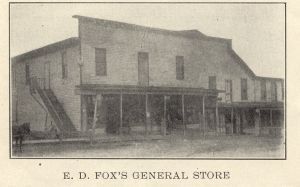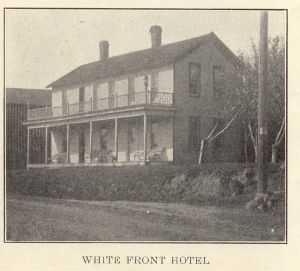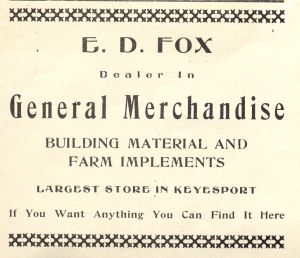|
Page 57 |
|
|
Keyesport is one of the oldest towns in the county. It was platted April 16, 1846, and incorporated as a village in 1897. Its first settler was Thomas I. KEYES. For many years after the coming of Tom I. KEYES, as he was familiarly known, the settlement was a trading post and was inhabited by a few Indians and white men who made a business of making rafts from rough lumber, and shipping bacon and hogs down the Kaskaskia river into
the Mississippi, and thence to New Orleans, where they would sell both the raft and its freight and return to St. Louis by steamboat and travel across Illinois with teams of oxen to Keyesport. Their trips required several months sometimes. Mr. KEYES built a small packing house wherein the hogs were killed and prepared for shipment, they would then be loaded on the rafts and the trip to the southern seaport would begin. Often these trips were the occasion for a jollification amongst the settlers of Keyesport, and for a day or two before leaving the villagers would assemble together and have a sort of feast. In those days timber along the banks of the river was very plentiful and rafts could be made for a mere song. KEYES operated a large saw mill near the river bank, and the timber was sawed into rough planks and from these plank rafts, sometimes forty and fifty feet long, were made. The rafts brought big money in New Orleans. For years this work went on. KEYES also owned the first store in the hotel and operated a bar in connection with it. Saloons were almost unknown then, but drinks were sold in the hotel, and gambling was indulged in every night. The settlement, like all others in the early days, had its rough element and many a brawl was started by the villagers. Among the first settlers to follow KEYES were John LIFRITS and Henry DELAYS, both Americans |
Judge HANK was one of th first merchants to follow KEYES in opening a store. Kerney COLE followed him. The little, unattractive, unkempt half border town began to take on an air of prosperity along about the early eighties and when the railroad was built through in 1883 the town began to grow steadily. The Jacksonville and Southeastern was the name of the road that built through that section of the State. A few years ago it was purchased by the Chicago, Burlington & Quincy R. R. Before the advent of the railroad, mail was brought to the village sometimes twice a week, sometimes only once during a week. William LANGHAM, the banker of Keyesport, came here when the railroad was built through the little city and became one of the city’s most prominent men. The oldest store, sill standing, is the one now occupied by E. O. BRYANT, the present mayor of the little city, and a general merchant. The first school was built 54 years ago. The first church was built along about the same time. There is a small Catholic church there, which is a mission, attached to the Church of Sandoval. Other denominations are represented, but all have not their own churches. Henry Lifrits conducted a store for many years in the city and did a big business during the civil war. He died twenty years ago. The first president of village was U.I.Hurd The first president of the village was U. I. HURD. Today the little town has a population of more than 500 souls. Part of the town lies in Clinton and part in Bond counties. The postoffice and bank and largest stores are on the Clinton county side. The railroad depot is also in Clinton county. The members of the
Village
Board are: |
|
Page 58 |
|
|
Ernest O.
POTTS,
Insurance Agent E.D. FOX The above named young business man conducts the largest and most completely stocked general store in the present City of Keyesport. He started into business three years ago, having bought out Wm. LANGHAM. His stock of goods is valued at $20,000 and includes dry goods, clothing, groceries, millinery, notions, shoes, caps, hats, queensware, glassware, graniteware, lumber, lime, cement building material of all kinds, furniture and implements. A yearly business of $75,000 is transacted by this store and for a town the size of Keyesport, it is rather a large amount of business to do. The town is a big trading point and supplies the farmers from parts of three counties. The capacity of the lumber yard adjoining the store is seven carloads. It is the only lumber yard in the city. Mr. FOX handles the John Deere implements, wagons and buggies and cream separators. The store he occupies has been used as a general merchandise store for the past 25 years.The store has the distinction of supplying more people than any other store in the entire eastern end of the county from north to south, and also is the supply center for many of the farmers of Bond and Fayette counties. Mr. FOX was born in Fayette county in 1878 and is the son of J. C. and Maria FOX. He is one of four children. He was married in 1898 to Jesssie DAVIS, daughter of John H. and Mary A. DAVIS and the couple have two children, both boys. E. O. BRYANT Twenty one years ago E.O.BRYANT started into business in Keyesport with a stock of about $1,500. By hard work and attending strictly to business he has increased his stock to $4,000 and does a yearly business of more than $10,000. He handles a complete line of everything in the general merchandise line, and occupies the oldest store building in the little city in the Northeaster part of the county. Aside from the general merchandise line he buys and ships poultry, butter and eggs. He has a large patronage, and is one of the most progressive citizens of the city. He was elected president of the village in 1912 to succeed E. F. ACKERMANN, who moved to Centralia. He was formerly an Alderman and member of the County Board of Supervisors. He was born in Wheatfield Township in 1866 and is a son of George W. and Sarah J. BRYANT, who were among the early settlers of the county in that section. He was one of five children. He was married in |
1892 to Annie LANGHAM, a native of England, but who has been a resident of Clinton county for forty years. PETERS’ Restaurant The only restaurant on the Clinton county side of Keyesport is owned and managed by Mrs. E.PETERS. She has been conducting it for the past four years. Four years ago she bought out the interests of Lyman WADE. Two years later the place was burned to the ground and she located her present place of business. She has been a resident of the city for five years and formerly lived in St. Louis for 21 years. She was located in Carlyle before moving to St. Louis. She was born in the county in 1854 and is a daughter of Philip and Bridget MURRAY. She is one of six children; she was educated in the schools of the country and was married in 1875 to Sidney B. PETERS. They were married by Rev. Father DEMMING, the pastor of the Catholic Church at Carlyle. Mr. PETERS was born in Perry County in 1852. Mrs. PETERS serves hot and cold lunches, sells candy, confectionery, fruit, soft drinks, tobacco, post cards, and is the headquarters for Litchfield bread. Her place of business is well patronized by the people of Keyesport. She has a host of friends living in and around the city. O.C. WELCH Mr. WELCH,the present Village Clerk, is one of the pioneers of the city, having located in Keyesport in 1857. He is in the real estate business and has been engaged in that line for the past twelve years. He was formerly connected with E. F. ACKERMANN but bought out his interests when the latter moved to Centralia. He has held various city and county offices, among them being Assessor, Supervisor, Chairman of the County Board, Town Clerk, Village Clerk and President of the Village Board. He was born in Robinson, Ill., in 1851, and was a son of Columbus and Mary WELCH, who died when he was very young. He was married in 1872 to Mandy KIGER and is the father of eight children, six of whom are living and all married. The youngest son stays with his father and is employed in Keyesport. Three excellent bargains for sale by Mr. WELCH are herewith described: Two hundred and forty acres, 6 miles southeast of Keyesport, all improved land, 25 acres in timber, rest in cultivation. Good wheat, meadow and corn land; fenced and cross-fenced. Plenty of barns and outbuildings; 6-room house, two stories; wells and orchard; price $60 an acre. Eighty acres, three miles southwest of town; all improved; 8 acres in timber; rest in clover; plenty of barns and outbuildings. Price $60 an acre. When Mr. WELCH located at Keyesport there was only one small hotel and store, a small packing house and a |
|
Page 59 |
|
|
few dwellings. For several years he ate at the table with the founder of the town, Thomas I. KEYES. He is the oldest business man in the city, in point of service, and is known all over the southern part of Bond county, part of Fayette and all of Clinton county. White Front Hotel The White Front Hotel was built eight years ago by William LIFRITS. It contains 12 rooms and the rates are $1.50 per day and well worth it. Mrs. W. A. LIFRITS manages the hotel, and has made it a paying proposition since she assumed charge. Formerly her husband had the management of the hotel until he was appointed Marshall of Keyesport. When he started to work as Marshall he found out that he could not be Marshall and manage a
hotel at the same time, so he turned the management over to his wife. The hotel is built upon the banks of the Kaskaskia river and commands a beautiful view of the valley surrounding Keyesport. Mr. LIFRITS has been a resident of the city since 1856, having been born in the city during that year. He is a son of John and Nancy Maria, who were numbered among the very early settlers of Keyesport. He was married in 1877 to Annie R. DILL of Maryland, and is the father of four children, all living and married; they live in different sections of the country.
|
For several years Mr. LIFRITS conducted a livery and dray business until he was appointed Marshall in 1887 for the first time. He served 14 years without losing a day and decided to resign. He was out for four years until he was prevailed upon by the citizens of Keyesport to accept the appointment again; then for several years he again served as Marshall; several times during those intervening years he resigned and went back until 1912 when he was re-appointed again under E. O. BRYANT. THE ILLINOIS TREES ARE THE BEST FOR ILLINOIS. Because they will create more State pride than anything else-an honest State pride based upon real achievement, not a false pride such as Edinburgh takes in her rock which she did not build. One of the loveliest trees in the world is the tulip tree, with its cup-like flowers of yellow, marked with orange, and this noble tree reaches its greatest size in the State of Illinois. Why not plant a mile of tulip trees along some wide, smoke-free road where the trees will be a joy for centuries? Why not plant hundreds of miles with elms? If people object that very tall trees shade the road too much, let us plant the small trees that are 'native to Illinois, such as the flowering dogwood, crab apple and hawthorn-all of which have a wealth of bloom in May, and beautiful fruits in the autumn. Probably no one would want a mile of the western catalpa, because of its conspicuous failings, butt we all want a group of it now and then for its gorgeous flowers. "I have always been struck with the prejudice of Illinois people against trees along the roadside," says Dean Davenport. "They seem to have settled upon these as the chief cause of mud, whereas the leaves of the tree will take more water out of the ground than will the sunlight which they intercept." The one "sure cure for mud is good roads, and if a good road is properly crowned, there will be no trouble from trees on the score of mud, s.-) say highway engineers of national reputation. Where in the world can you find more beautiful shrubs than the high-bush cranberry, and other viburnums, our shrubby dogwoods, our elders and our sumachs? They are cultivated in eastern gardens; why not along our roadsides where they belong? The flowers of trees are frequently so high up that we cannot enjoy theta, but the flowers of shrubs are just at the right level to see, touch and smell. Shrubs will give us more flowers and more color the year round than anything else that can be successfully planted along the roadside. GROWING HORSE-RADISH FOR PROFIT. We have had several letters and some clippings on this subject, and as we can not give any of them in full', we give a summary of all. Every one of the writers discourages the idea of making a specialty of growing the roots, as a market for the rots, unless of the very best shape, is hard to find. Where but a limited amount can be disposed of to local buyers, or through arrangements with commission houses in the cities, the straightest roots can be sold as dug; but the roots which are poorly and irregularly shaped will have to be sold grated and in bottles. A plant that grows a lot of side root branches, or divided main root, will not sell well anywhere. A limited market can be worked up for the grated root put up in bottles with a gross weight of one pound, containing something over half a pound of the grated root, well mixed with good vinegar. Such bottles are sold at retail for about ten cents each. In the United States as a
whole a little more than onehalf of the acreage devoted to cereals is
in corn, a little less than one-fourth in wheat, and somewhat more than
one-sixth in oats. |
This file last modified





